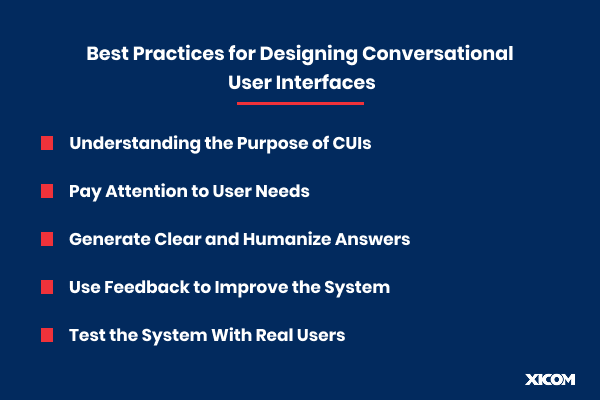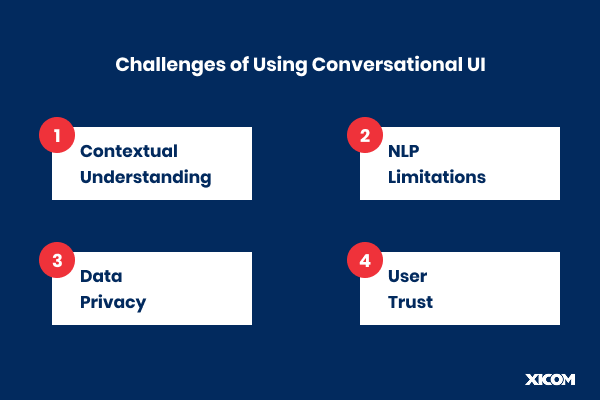Jan 31, 2025 Artificial Intelligence
Conversational User Interfaces: Best Practices and Tools
Jan 31, 2025 Artificial Intelligence
Table of Contents
Jan 31, 2025 Artificial Intelligence
Using conversational user interfaces in the digital landscape is bringing one of the most transformative shifts. But what’s the idea behind using conversational interfaces and how they are making a huge difference in customer support?
Being an investor, if you are also chasing the same question, then read this!
Recently, the market has seen a surge in e-commerce startups, many launched by entrepreneurs with limited technical expertise. One of our clients was among them. With only a capital investment and a vision, he decided to hire a team of engineers to build an e-commerce app powered by AI capabilities.
Fast forward to launch night: the sales are live, and everything seems to be running smoothly – until a customer encounters a critical issue on the platform. Frustrated, she turns to the app’s chatbot instead of waiting until morning for human assistance. Within seconds, the Conversational User Interface (CUI) acknowledges her query, identifies the problem, and delivers a personalized, step-by-step solution – all without human intervention.
Quick highlights of implementing CUIs in business apps are:
In simple words, Conversational User Interfaces (CUIs) are user interfaces that help humans interact with computers using voice or text. The conversational interfaces are designed to bridge a gap between humans and machines and build a communication platform that fosters the personal connection between services and their uses.
With the reports saying conversational user interfaces like OpenAI’s ChatGPT and Microsoft 365 CoPilot will be vital for driving efficiency and meeting customer requirements by 2028, many giant IT firms like Google, Apple, Facebook, and Amazon are seeing conversational UIs as the future of development.
As emerging technologies are speedily changing the way we interact with technologies, it is fair enough to say that bots will soon be replaced with apps, enabling users to interact with their preferred digital services directly.
The reports say that the number of voice assistants worldwide will reach 8.4 billion in 2024, which is expected to increase to the next level as 85% of customer interactions are projected to be handled without human intervention by 2025. All thanks to major advances in AI-driven interfaces.
Conversational UI is more than just a trend. From implementing chatbots on websites to virtual assistants like Amazon’s Alexa, conversational UIs are changing the way people interact with technology.
Conversational User Interface (CUI) is an interface design that allows users to interact with technology through natural language, either via text or voice. They are transforming the communication process between humans and computers by enabling natural, seamless communication through text or voice.
Gone are those days, when businesses used traditional interfaces in apps or websites that required clicking icons or using specific commands. Instead, CUIs allow users to engage in a conversational flow, just like talking to another human. Whether it’s through the web, mobile, or desktop applications, CUIs empower users to interact with computers in their natural language, bridging the gap between human expectations and machine functionality.
The most common example of CUIs that 70% of businesses are leveraging to enhance support are voice assistants. Whether it be Amazon’s Alexa, Facebook Messenger chatbots, Siri, or Google Assistant, they all are the biggest trendsetters in customer support. These conversational platforms are designed to cater to a plethora of tasks such as shopping, managing schedules, making phone calls, searching for products, buying tickets, or even ordering food.
It simplifies complex processes by enabling users to perform tasks effortlessly using voice or text, without requiring a deep understanding of technical systems or syntax.
Conversational User Interfaces (CUIs) function by mimicking human-like interactions, allowing users to access services or information through natural communication methods.
There are mainly two types of CUIs:

Source: explodingtopics
By choosing AI development services, you can easily integrate advanced UIs into your existing platform. But the central question is how do they work?
Well, the interface uses advanced technologies to understand, process, and respond to user inputs in a way that feels human-like and simple to interpret. To make it work,
So having these powerful technologies at the backend, CUIs work in a simple pattern.
Conversational User Interfaces (CUIs) are already gaining momentum in various industries due to their ability to handle multiple queries and facilitate natural and intuitive interactions between users and digital systems.
This increase in popularity can be attributed to several key benefits:
CUIs simulate human-like interactions, creating a more engaging and natural experience. This conversational approach makes users feel more connected and valued.
CUIs simplify interactions by removing the need for technical know-how. Users can effortlessly interact with systems through voice or text, ensuring accessibility for people of all ages and abilities. This makes services more inclusive and user-friendly.
With advanced AI technologies, CUIs can analyze user behavior, preferences, and historical data to offer tailored responses and solutions. This level of personalization fosters a deeper connection between businesses and their customers.
CUIs, especially chatbots, allow businesses to handle a high volume of customer queries simultaneously, reducing the need for extensive customer support teams. This not only saves costs but also ensures round-the-clock service availability.
By delivering targeted responses and incorporating clear calls to action, CUIs can guide users more effectively through their journey, whether it’s making a purchase, booking a service, or seeking information. This streamlined process often leads to higher conversion rates.
Unlike traditional interfaces, CUIs can scale effortlessly to accommodate growing user bases. Businesses can handle increased interactions without compromising service quality, ensuring efficiency and customer satisfaction.
There are several benefits that you can leverage by hiring experts who offer refined NLP services and embedded machine-learning models. But before you make such investments, it is worth understanding the best practices for designing conversational User Interfaces.
Designing conversational user interfaces (CUIs) is a unique challenge that requires a thoughtful strategy and a careful user-centric approach. Here are some best practices to guide the design process and create an engaging, efficient, and intuitive conversational interface that you need to follow to drive the best results from CUIs.

Before you dive straight into designing a conversational interface, make sure you’re clear with your purpose and the tasks that you are expecting to accomplish. Whether it’s a customer service bot, a voice assistant, or a shopping assistant, determine what exact problems your conversational User interface is addressing and which tasks it will handle.
To ensure that the interface remains focused and efficient, smart businesses always opt for top mobile app development services. So make sure you choose your CUI designing team wisely.
The success of a conversational UI is deeply tied to understanding and addressing the user’s needs. There is no use in implementing fancy UIs and hiring expensive UX designers, if it is not contributing to user engagement, then all your efforts will be drained.
So it is important to consider user goals, preferences, and behaviors when designing the conversation flow to make it impactful. While designing the CUIs, the interface must make interactions feel natural, intuitive, and responsive to the user’s requests.
The interface must feel natural, intuitive, and responsive, ensuring a seamless interaction with the system.
For this here are the key considerations that you can follow:
By focusing on these user-centric design elements, you ensure that the conversational interface serves as a helpful and responsive assistant that guides users through their journey without frustration.
For users to have a smooth and efficient experience, make sure that conversational user interfaces generate clear, concise, and easy-to-understand answers.
In addition, avoid technical jargon, complex sentences, or overly formal language. Use simple, everyday language to ensure that users can easily follow the conversation and get a solution.
Continuous feedback is critical for refining the performance of a conversational UI. By analyzing user interactions and collecting feedback, designers can identify pain points, common errors, or areas of confusion.
Incorporating this feedback ensures the interface will keep evolving and improve over time to meet user expectations more effectively.
Usability testing is essential for ensuring that a conversational interface works as intended. Conduct tests with real users to identify potential usability issues. Observe their interactions, gather feedback, and refine the system based on their experiences. Real-world testing helps uncover areas of friction that may not be apparent in design stages.
By adhering to these best practices, businesses can design conversational interfaces that are user-friendly, engaging, and capable of providing a seamless experience across various digital platforms.
There is no doubt in this fact that Conversational User Interfaces are transforming customer support and services. However, the impact of CUIs on user engagement and customer support depends upon the quality of tools that you choose to build CUIs. So here are the top technologies that you can refer to for developing CUIs for the website and mobile app.
| Tool | Description | Uses |
| RASA UI | Open-source tool to build contextual AI assistants. | Ideal for creating intelligent, contextual chatbots and virtual assistants. |
| Dialogflow | Platform by Google to build natural and rich conversational experiences. | Used to create conversational UIs with NLP capabilities, integrating with Google’s ecosystem. |
| Wit.ai | A platform to build applications and devices that understand speech and text. | Helps create voice and text-driven conversational interfaces for applications and devices. |
| Pandorabots | Platform for building and deploying chatbots. | Best for businesses looking to deploy chatbots on websites and social media platforms. |
| Careerbot.ai | AI-driven tool to connect businesses with the best talent by leveraging employees’ connections. | Helps enterprises build bots for recruitment and talent acquisition. |
| Meekan | AI scheduling assistant that syncs calendars in seconds. | Ideal for creating scheduling bots that assist with meetings and appointments. |
| Many bot | Platform to create Telegram bots without coding. | Useful for businesses to create and deploy bots for the Telegram platform. |
| Amazon Lex | Powered by the same deep learning technologies as Alexa, it allows the building of conversational interfaces. | Helps businesses integrate chatbots or voice assistants into mobile apps and websites. |
| IBM Watson | An AI-powered platform that enables advanced conversational systems. | Used for building sophisticated bots for customer service, data analysis, and more. |
| Microsoft Cognitive Services (LUIS) | Adds conversational intelligence to apps using Microsoft’s Language Understanding service. | Ideal for developers looking to create natural language understanding capabilities. |
| BotMock | A drag-and-drop tool to create chatbot prototypes. | Used for prototyping and testing chatbot interactions before deployment. |
| Microsoft Bot Framework | Framework for building, connecting, deploying, and managing intelligent bots across multiple platforms. | Provides tools for creating bots that can work across web, mobile apps, Microsoft Teams, etc. |
| Motion AI | Robust platform for enterprises to build and deploy bots across various mediums, including Facebook Messenger, Slack, email, Web, and SMS. | Ideal for building bots for multiple messaging platforms and integrating with enterprise tools. |
| Dexter | A platform for businesses, brands, and individuals to create meaningful automated conversations. | Helps companies build personalized chatbot interactions and manage user queries effectively. |
| SuperScript | Dialog system and bot engine for Conversational UI. | Enables developers to create conversational interfaces with a focus on system integration. |
| Bootkit | Leading tool for building chatbots, apps, and custom integrations for major messaging platforms. | Used for developing advanced chatbots with custom integrations into messaging platforms. |
| Reply AI | Platform for building and managing conversational strategies. | Helps businesses create and manage omnichannel conversational interfaces. |
| Dashbot | Analytics platform for chatbots with a focus on user insights and engagement metrics. | Provides analytics for improving chatbot performance and user engagement. |
| Botsociety | Allows the design, testing, and prototype creation for conversational interfaces. | Best for visualizing and testing conversational UI and creating interactive bot prototypes. |
| Layer | Platform to build custom chatbots and messaging apps. | Helps developers build messaging apps and bots with user authentication and custom workflows. |
| Statsbot | Tool for building conversational analytics bots. | Enables the creation of bots to analyze data and provide insights for users in real-time. |
| BotMetrics | Analytics platform for measuring and optimizing chatbot performance. | Tracks chatbot performance and user engagement to improve overall experience. |
| ChatterBot | Python library for creating conversational agents using machine learning algorithms. | Ideal for developers seeking to create simple conversational bots with machine learning. |
| Massively | Tool for creating chatbots with AI capabilities. | Provides tools for developers to create bots capable of handling complex customer interactions. |
Conversational UIs are leaving a deep impact on various industries by improving customer engagement, streamlining processes, and enhancing user experience. Leveraging the power of conversational AI and NLP development services, CUIs are transforming traditional business models and reshaping how companies can interact with customers.
So here we can have a look at the profound impact of conversational UIs across various sectors:
Did you know that 33% of the world’s population shopping online and will make the e-commerce industry worth $8 trillion by 2027?

These stats are really big to understand there will be huge scope for generating revenue from the industry. All you need is to create an e-commerce app using AI capabilities and adopt the right strategy.
Businesses that are ready to transform their strategies and operational models can look forward to integrating conversational UIs. The direct benefit of incorporating CUIs into the e-commerce business is they can push the online shopping experience.
Another benefit of integrating chatbots into websites and mobile apps is online retailers can offer personalized product recommendations that can help increase 200% sales. Amazon is one of the early adopters.
Implementing conversational user interfaces in e-commerce websites as it assists in answering questions in real-time, and can even handle complete transactions without requiring human intervention.
This practice ultimately reduces cart abandonment, increases customer satisfaction, and at last drives sales. Conversational UI enables a seamless shopping experience that allows customers to receive the help they need instantly.
The contribution of AI is huge in the healthcare sector. According to recent data, 56% of healthcare organizations are currently incorporating chatbots into their applications, indicating a significant adoption rate within the healthcare industry for chatbot technology.
Do you realize why AI chatbots are making huge strides in the healthcare sector?
Well, using conversational UIs like chatbots provides automated services that enhance patient care. Healthcare providers are utilizing CUIs to simplify appointment scheduling, give patients timely reminders for medication, and offer preliminary symptom checking.
Ultimately, this small practice helps healthcare providers streamline administrative tasks, reduce waiting times, and improve patient outcomes.
If you are still lacking to provide better care to the patients, then create a healthcare app using data analytics and AI to redefine the care
Customer services in the banking and financial industry are a serious concern. Adopting conversational UIs can help greatly in enhancing customer services and making financial transactions smoother.
From managing accounts and investments to streamlining loan applications, using AI in banking is becoming an essential tool for customer interactions. Financial institutions are using chatbots to provide real-time assistance with account queries, transaction updates, and even fraud detection.
All you need is to adopt top technologies like blockchain in banking or AI capability in Fintech apps to automate routine inquiries and increase transparency in transactions. In addition, CUIs can further help reduce wait times and free up human agents for more complex tasks.
Customer support and services are the key areas where conversational user interfaces make a huge difference. Traditional support systems often struggle with high volumes of customer requests, leading to long response times and decreased customer satisfaction.
This is where the chatbots are equipped to handle repetitive inquiries efficiently, providing instant responses to common questions.
With conversational UIs, businesses can scale their support operations without increasing human resources, all while ensuring customers receive timely and accurate assistance.
These are the few major ways Conversational User Interfaces are impacting businesses across industries. But before you jump straight to hire an app development company to implement conversational user interfaces, it is important to know that they come up with their own set of challenges.
While conversational UIs offer vast benefits, there are several challenges that businesses must address to ensure optimal user experiences and operational efficiency:

One of the primary hurdles that come across in implementing conversational UIs is understanding the full context of a conversation. Users may provide incomplete or ambiguous information, making it difficult for systems to respond accurately.
Without a clear understanding of the user’s intent, a conversational UI might provide irrelevant or incorrect responses. To overcome this, conversational UIs need to integrate more advanced AI and machine learning models that can process and learn from user interactions in real time.
Despite significant advancements, Natural Language Processing (NLP) still faces challenges, especially in understanding a few questions of human language. It would be anything like sarcasm, colloquialisms, and regional dialects that are posing significant barriers to comprehension.
When conversational UIs misinterpret these words, it can lead to user frustration and may impact customer trust. This is where you need to look for an AI development company that conducts continuous improvements to NLP algorithms and AI models more sophisticatedly by addressing these issues. However, they still represent a limitation in the current state of conversational UIs.
When using conversational user interfaces in web apps, data privacy is one of the biggest concerns. The growing use of conversational UIs comes with the collection of vast amounts of personal and sensitive user data. This raises significant concerns regarding data privacy and security, especially in industries like healthcare and finance.
Ensuring the utmost data security while collected by conversational UIs is stored securely and handled in compliance with privacy regulations (such as GDPR) is paramount. Businesses need to prioritize robust data protection strategies to build trust with users and mitigate the risks of data breaches.
Establishing trust in conversational UIs is a long-term process. Users may be hesitant to fully rely on chatbots or voice assistants, especially if they’ve encountered mistakes or inaccurate information in the past.
To build trust, businesses need to ensure that their conversational UIs are accurate, responsive, and capable of handling user queries effectively. Offering users the option to escalate issues to a human agent when needed can also help build confidence in the system.
The adoption of conversational UIs is all set to grow across various industries, and businesses can leverage the significant rewards by integrating these technologies into their operations. Whether you’re an e-commerce platform looking to enhance your customer service, a healthcare provider aiming to streamline patient interactions, or a financial institution striving to deliver real-time support, seamless implementation of conversational user interfaces can make a huge difference.
If you are also looking to implement conversational UIs, then partnering with a software development company like Xicom can be a strategic move. We have a dedicated team specialized in building and integrating custom conversational interfaces tailored to your specific business needs.
Here we have gathered some additional information related to conversational user interfaces that help you make an informed decision.
Conversational UI refers to designing interfaces that enable users to interact with digital systems using natural language. It can be either through text-based chatbots or voice assistants like Siri. It allows for more user-friendly interactions between users and businesses.
Conversational UIs can offer various benefits if implemented strategically. It includes enhancing customer engagement, improving response time, and automating repetitive tasks. Moreover, with CUIs businesses can streamline business operations and drive better growth opportunities.
For e-commerce, CUIs can be used for product recommendations and order tracking. In healthcare, it can be used for appointment scheduling and symptom checking. In banking and finance, businesses can use it for account management and fraud alerts, and in customer services, it can be used to automate FAQs and customer responses.
Xicom being a leading software development company follows the best practices in mobile app and website development. Our experts deeply analyze the existing system, find the scope and then build a strategy to incorporate conversational UIs to drive better ROIs.